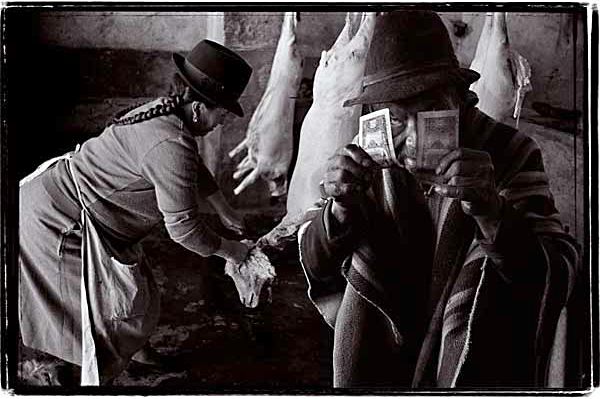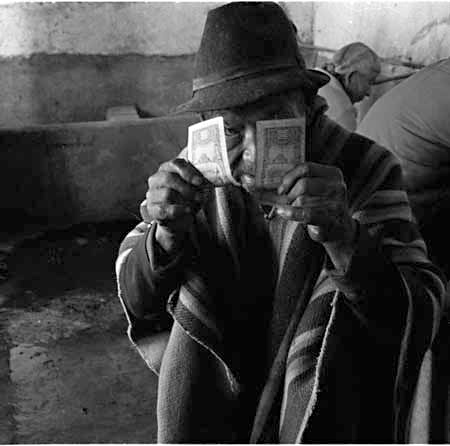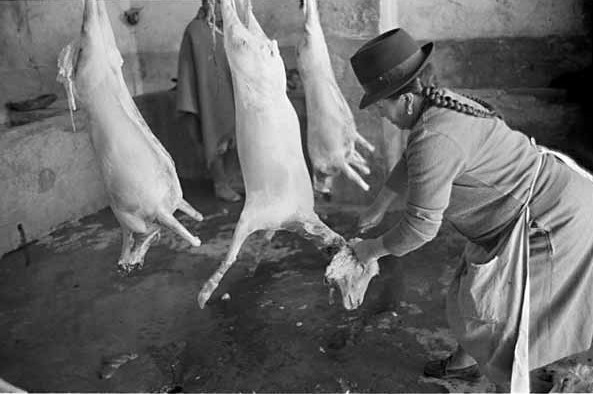| Redefining Documentary Photography |
 |
| Written by Pedro Meyer |
|
When presenting some of my digital pictures, I am frequently confronted with the comment: "but surely this is not a documentary photograph, is it?"
Before we move on to respond, let us first establish hopefully with some degree of clarity what we understand by a documentary photograph. As I see it, the intentions of a documentary photographer are to record some aspects of reality, by producing a depiction of what the photographer saw and which portends to represent that reality in as objective a manner as possible.
If we can agree to that description, I can already see our critics pounding on their desks accompanied by some degree of glee on their faces, as they suggest that this is precisely the reason why there is no room for the computer to be used in recreating documentary images.
I believe we have already discussed in all sorts of forums the fact that photography per se, is tantamount to manipulation. That the impact of the lens selected, the film chosen, and all the other technical variables leave ample room to question the so called "faithful representation" of reality. So let us not mull over this one endlessly, as I think it thins the debate rather enhances it.
Let us explore today, the parallels between photography and other forms of documentary work. For instance, a journalist brings together his writings, which represent a synthesis of what the journalist saw and/or heard, above all by what he imagines are the lines of reason behind the information selected. The journalist is not some copier machine that simply reproduces mindlessly what is placed on the platen in front of her. He weaves and puts together the information in order to insure that it accurately portrays the information presented in a decision making process that supports the story being presented.
A documentary filmmaker does not just shoot film or video without some sort of editing process in mind. We only assume that the actors are not hired, that they are real life characters, and that the settings are also real life environments rather than constructed sets. Of course one can go on from profession to profession related to documentary work, and you will always find the same sort of rationale; the belief that the representation was based on real life situations and that the information however real still had to be processed and edited before it was presented to the public.
So why are so many people up in arms about the idea that a photograph edited in the computer is not really a true documentary representation? As I have come to understand it, it has mainly to do with past traditions and customs. It apparently flies in the face of reason, that if one would alter an image, it no longer could call itself a document. What is wrong in that analysis is that any and all alterations have been treated equal (they are all bad). We know for a fact that not all alterations have the same justifications behind them, that some alterations can even contribute to enhance the veracity of an image rather than the opposite. Furthermore, many of the fears related to the conceptual changes for photography have to do mainly with a loss of certainty of what the photograph actually is delivering, in so far as a document, with little debate about the veracity of the content of a given image.
We are of course dealing here with the same sort of ethical debates around editing a story, be that with text or film, even sound tracks, something everyone has been discussing for a long time. For photography it is no different. Why should it be? If anything is different it's because in the past we could not reasonably edit photography in the way we can today, so when the tools first appeared that empowered us to do so, everyone just ran for the exits. All those other mediums had always been edited and were malleable to the nth degree; photography in that sense, was less flexible. Not that one could not alter documentary images, just ask the Soviets about all that they did in this respect. I sustain that photography always lived a life of false pretenses. Today when we intend to remove that disguise all sorts of defense lines are drawn.
Of course photography can lead to deception, it always could. What is more, it's open-ended nature in so far as meaning goes, has always been used to support whatever the intentions of the photographer. The digital age has not rushed in an avalanche of alterations as some would have thought would be the case. If one looks around what is being produced under the name of photographs one will discover that these are mostly illustrations. Another category that has grown recently is that of expanding the realm of the "fantastic" again with no attachment to the real world. What is less evident however is the work that is being produced that looks like traditional photographs but created with untraditional methods, namely digital ones. The reason for this is quite obvious: unless you are willing to offer the recipe for how you made the image, no one can really tell what was done (provided it was done well). That is what makes people so nervous and unwilling to consider as documentary an image produced digitally.
Let us look at the cover of ZoneZero this month. We decided that the title for this image would be: "Where is the Money?" (Which in Spanish has a double entendre that is quite nice, as the title "A dónde está la Lana" is based on "lana" meaning at the same time money as well as wool, for instance that of the sheep in the background). And the title "Where is the Money" also brings us back to that famous sentence by Cuba Gooding Jr. asking Tom Cruise repeatedly: "Where is the Money?" in the film Jerry Maguire (1996) . Or in looking at the image one could also recollect that other famous phrase; "Greed is Good" by Michael Douglas in the film, WallStreet (1987). For me it was interesting to relate such "first world" movie sentences to a reality in the "third world". I guess that when it comes to some basic human attitudes we are all universal.
Interesting questions arise by the juxtaposition of the man showing us the money. Why does he put up that money? Is he asking us to pay for something? Is he doing so because he wants money for being photographed? Is he selling us some sheep meat? Does he think he needs to pay for his photograph? What is the relation of power in that encounter between the photographer and the subject and as an extension us the viewers? What role do the sheep represent in all of this? Are they symbolic of something other than their physical presence?
Let us now evaluate the elements, which compose the image. First is the issue of the origin of the parts used. In this case the two main elements are the man holding the money and the background image with the sheep being skinned. Both pertain to the same place and were take in contiguous moments in time. They belong together as it were, as they have their common roots of space and time in a small village in Ecuador where I took the pictures. The only thing that did not occur in the final picture is that they appeared visually as they are presented here.
The background picture is turned left to right in order to have the light fall in the same direction in both components of the final image, as well as making space for the man holding the money. Such an alteration, I consider no different than what ordinary editing does in film, or when words are accommodated for better reading within a text. However this leads to an interesting issue within photography, namely that of luck.
Had all these elements appeared before my camera as they are in the final picture, I would not have required doing anything further. Photographers became accustomed to the notion of "having content and geometry make an appointment", as Max Kozloff once stated so eloquently, in great part through luck. One knew one was "lucky" to have everything fall into place, even though we took full credit for all the timely decision making abilities involved. The only problem with some of these so called talents, is that more often than not, the coincidence of content and geometry coming together would not have been visible to the plain eye under the best of circumstances. Or worse yet, one would proceed like fishermen who go about their task casting a wide net, and then seeing what came up in the catch. Photographers shooting off numerous rolls of film with motors on the camera in order to shoot faster than even the eye can see, and then going through the "catch" to discover which were the "good ones". The process then called euphemistically, editing.
I am of course not questioning the validity of patience that some great photographers have exerted in order to get at exactly the image that they imagined, but even when patience was at the core of such endeavors an element of chance would inevitably crop up here and there.
I personally dislike the notion that my work be determined mainly by luck. I'd rather fail on my own efforts rather than attribute poor results to the absence of luck. The reverse of this argument is of course that I like to determine what an image looks like on the basis of my intentions, not chance.
Having said that, photography has today a wonderful opportunity with which to enhance its options to create an image aside of luck. Now I can, like other creators who choose to create a documentary story, pull all the strings of what makes an image a stronger one, by either eliminating, adding, re organizing, those pieces of information which make up the picture.
As far as the factual evidence of "what was", as some like to state, are those traces of light which give evidence of what was there. In my picture nothing appears within the frame that wasn't there, in so far as the reality of the space. Yes the order has been altered and changed, but then what is the difference between my computer alteration, and the photographer who chooses his or her angle to place a camera? Or when the photographer asks, sometimes by nudging ever so lightly for those depicted to move their location to a more favorable light or position.
Colin Jacobson, wrote in a letter to me some years ago about his concern that in the future, digital photographers would become increasingly sloppy, because they (photographers) could, after all, erase those elements, which they were too lazy to deal with in the first place. I am sure that sloppy work preceded digital technology and thus the argument about such risks only tended to obscure the rich potential for making ever better images, precisely the opposite of his concerns. He was preoccupied the tools would be misused, I was convinced of the opposite that they would lead to creativity not sloppiness.
I urge photographers everywhere to test the waters, to experience coming up with documentary work that is very strong by means of applying digital technology. The risks for abuse are obviously present, but they have always been there, for other mediums as well, none of this ever stopped responsible creators from using all their tools. Documentary Photography has been redefined; it is time to prove it.
Pedro Meyer
For comments post a message in our forum section at ZoneZero.
http://zonezero.com/editorial/abril00/april.html
|







